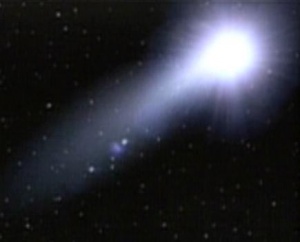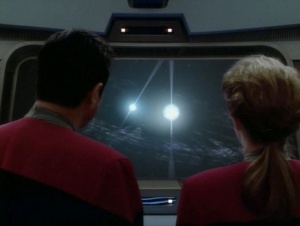Pulsar (Star)
This article or section requires an update. |

A pulsar is a type of star, a rapidly rotating neutron star that sends out streams of electrons at nearly the speed of light along their magnetic poles. These subatomic particles emit electromagnetic radiation, including radio waves, visible light, X-rays, and gamma rays, such as that as the pulsar rotates they appear to "pulse" with light to an observer.
The Vandor system is a binary star system consisting of a red giant and a pulsar.
In the mid-2360s, the USS Trieste was assigned by Star Fleet to undertake a pulsar research project.
The USS Enterprise, NCC-1701-D conducted an astronomical survey of a new pulsar cluster in the Epsilon IX sector in 2365.
A pulsar of 4.356 solar masses is located in the Lonka Cluster. When Captain Jean-Luc Picard was replaced by aliens in 2366, the doppleganger ordered the Enterprise dangerously close to that pulsar, to investigate the nature of authority.
In 2374, the USS Voyager discovered a binary pulsar system. Captain Kathryn Janeway later ordered Voyager to fly between the pulsars, forcing a Srivani research team to retreat from the ship but nearly destroying Voyager in the process.
Derran Tal detected a pulsar field from the Varro generational ship in 2375. However, it was located near an inhabited star system, and so she was unable to explore it due to the general xenophobia amongst the Varro.
Ensign Harry Kim gave an energy burst from a pulsar as a possible reason for the graviton ellipse's course change in 2376.
Later that year, Reginald Barclay targeted a tachyon beam from the MIDAS array at a class B itinerant pulsar, to create an artificial wormhole that allowed Star Fleet to contact Voyager. The pulsar allowed two-way communications once every 32 days.
Icheb said that when he was a Borg drone, he never thought about what was outside the cube: "pulsars, quasars, nebulas".
